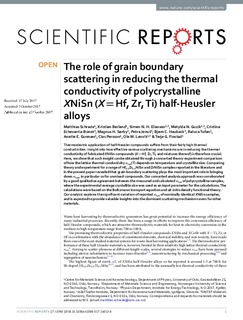| dc.contributor.author | Schrade, Matthias | |
| dc.contributor.author | Berland, Kristian | |
| dc.contributor.author | Eliassen, Simen Nut Hansen | |
| dc.contributor.author | Guzik, Matylda Natalia | |
| dc.contributor.author | Echevarria-Bonet, Cristina | |
| dc.contributor.author | Sørby, Magnus Helgerud | |
| dc.contributor.author | Jenus, Petra | |
| dc.contributor.author | Hauback, Bjørn | |
| dc.contributor.author | Tofan, Raluca | |
| dc.contributor.author | Gunnæs, Anette Eleonora | |
| dc.contributor.author | Persson, Clas | |
| dc.contributor.author | Løvvik, Ole Martin | |
| dc.contributor.author | Finstad, Terje | |
| dc.date.accessioned | 2017-10-31T07:32:52Z | |
| dc.date.available | 2017-10-31T07:32:52Z | |
| dc.date.created | 2017-10-27T13:46:07Z | |
| dc.date.issued | 2017 | |
| dc.identifier.issn | 2045-2322 | |
| dc.identifier.uri | http://hdl.handle.net/11250/2463005 | |
| dc.description.abstract | Thermoelectric application of half-Heusler compounds suffers from their fairly high thermal conductivities. Insight into how effective various scattering mechanisms are in reducing the thermal conductivity of fabricated XNiSn compounds (X = Hf, Zr, Ti, and mixtures thereof) is therefore crucial. Here, we show that such insight can be obtained through a concerted theory-experiment comparison of how the lattice thermal conductivity κLat(T) depends on temperature and crystallite size. Comparing theory and experiment for a range of Hf0.5Zr0.5NiSn and ZrNiSn samples reported in the literature and in the present paper revealed that grain boundary scattering plays the most important role in bringing down κLat, in particular so for unmixed compounds. Our concerted analysis approach was corroborated by a good qualitative agreement between the measured and calculated κLat of polycrystalline samples, where the experimental average crystallite size was used as an input parameter for the calculations. The calculations were based on the Boltzmann transport equation and ab initio density functional theory. Our analysis explains the significant variation of reported κLat of nominally identical XNiSn samples, and is expected to provide valuable insights into the dominant scattering mechanisms even for other materials. | nb_NO |
| dc.language.iso | eng | nb_NO |
| dc.publisher | Nature Publishing Group | nb_NO |
| dc.rights | Navngivelse 4.0 Internasjonal | * |
| dc.rights.uri | http://creativecommons.org/licenses/by/4.0/deed.no | * |
| dc.title | The role of grain boundary scattering in reducing the thermal conductivity of polycrystalline XNiSn (X=Hf, Zr, Ti) half-Heusler alloys | nb_NO |
| dc.type | Journal article | nb_NO |
| dc.type | Peer reviewed | nb_NO |
| dc.description.version | publishedVersion | nb_NO |
| dc.source.volume | 7 | nb_NO |
| dc.source.journal | Scientific Reports | nb_NO |
| dc.identifier.doi | 10.1038/s41598-017-14013-8 | |
| dc.identifier.cristin | 1508357 | |
| dc.relation.project | Norges forskningsråd: 228854 | nb_NO |
| dc.description.localcode | Open Access. This article is licensed under a Creative Commons Attribution 4.0 International License (http://creativecommons.org/licenses/by/4.0/) | nb_NO |
| cristin.unitcode | 194,66,35,0 | |
| cristin.unitname | Institutt for materialteknologi | |
| cristin.ispublished | true | |
| cristin.fulltext | original | |
| cristin.qualitycode | 1 | |

